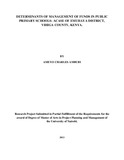| dc.description.abstract | Financial management is meant to counter man’s greed, selfishness and aggressiveness in the process of using scarce resources and rational approach in resource mobilization. Furthermore, all major deliberations depend on financial equation (cook, 1979). Primary school education in Kenya is becoming increasingly affordable, though the standards and performance have continued to deteriorate due to mismanagement of funds. The government of Kenya in 2003 introduced FPE and thus increasing enrollment and causing strain on the available resources in schools. In Emuhaya district of Vihiga county, the situation is even worse to an extent that the public doubt the preparedness of the head teachers and the SMCs in management of funds. Many of them have fallen victims of mismanagement associated with misappropriation or intentional embezzlement hence the need to conduct this study. The purpose of this study was to establish determinants of management of funds in public primary schools in Emuhaya district, Vihiga county. The objectives of the study were: to examine how procurement procedures determines management of funds, to assess how auditing determines management of funds, to establish how financial book keeping determines management of funds and assess how the SMCs determines management of funds in public primary schools in Emuhaya District Vihiga County. It was assumed that the study was to be significant to the policy makers in establish relevant policies. It was also hoped that the study was to contribute to the body of knowledge. The study was delimited to Emuhaya district, Vihiga county. It had a theoretical and conceptual framework and a summary of the literature review. The researcher used descriptive survey design which helped him collect quantitative data for analyzing using descriptive statistics technique. The researcher targeted 95 public head teachers, chairpersons and treasures of the 95 public primary schools, a DQASO and one auditor. Simple random sampling was used to sample 31 schools then purposely sampled 31 head teachers and 31 treasures/chairpersons of the 31 schools, the DQASO and the auditor. The data was collected using questionnaires and interview guides. The data was then analyzed and presented by use of descriptive statistics such as frequencies, percentages and tables. The data was then discussed. Singleton noted that the most commonly method used for reporting descriptive survey research is by developing frequency distributions, calculating percentages and tabulating them accordingly. The study revealed that all SMC members had form four education. Most schools which involved SMCs in formulating budgets had minimal debts, auditing was mostly done ones a year by external auditors. The schools where the SMCs met frequently had their projects completed on time. The study recommended financial training is organized for the school managers, schools should carry out appraisal every term and give allowances to SMC members and head teachers. Head teachers should work closely with the SMC and follow school budgets. | en |

